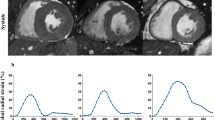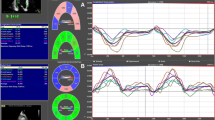Abstract
Background To assess left ventricular volumes and mass by cardiac magnetic resonance imaging in relation to conventional cardiovascular risk factors and coronary atherosclerotic plaque burden in master marathon runners aged ≥50 years. Methods Cardiac MRI was performed in 105 clinically healthy male marathon runners (mean age 57.3 ± 5.7 years, range 50–71 years) on a 1.5 T MR system (Avanto, Siemens, Germany). Cine steady state free precession images in standard long and short axes views were acquired to assess left ventricular volumes and mass. Cardiovascular risk factors (blood pressure, HDL/LDL cholesterol, smoking, body mass index) were assessed and coronary artery calcification (CAC) was quantified by electron beam computed tomography. Results Left ventricular muscle mass (mean LVMM = 140 ± 27 g; 73 ± 13 g/m²) increased with increasing left ventricular end-diastolic volume (mean LVEDV = 137 ± 32 ml; 72 ± 15ml/m²) (r = 0.41, P < 0.0001) and with systolic (r = 0.33, P = 0.005) and diastolic (r = 0.28, P = 0.005) blood pressures. Left ventricular EDV increased up to the age of 55 years, but decreased thereafter. Runners with LVMM ≥150 g had significantly higher CAC scores than runners with LVMM <150 g (median CAC score 110 vs. 25, P = 0.04). Conclusions Increases in LVMM and LVEDV may not only represent a response to exercise but are dependent on age and blood pressure, also. In addition, a left ventricular hypertrophy without an increase in volume may be an indicator for early subclinical cardiac alterations in response to risk factor exposure.




Similar content being viewed by others
References
Running USA Road Running Information Center (RRIC): Trend & Demographics (2007) http://www.runningusa.org/cgi/mar_repts.pl
Maron BJ, Douglas PS, Graham TP et al (2005) Task force 1: preparticipation screening and diagnosis of cardiovascular disease in athletes. J Am Coll Cardiol 45(8):1322–1326. doi:10.1016/j.jacc.2005.02.007
Thompson PD, Franklin BA, Balady GJ et al (2007) Exercise and acute cardiovascular events placing the risks into perspective: a scientific statement from the American Heart Association Council on Nutrition, Physical Activity, and Metabolism and the Council on Clinical Cardiology. Circulation 115(17):2358–2368. doi:10.1161/CIRCULATIONAHA.107.181485
Maron BJ, Poliac LC, Roberts WO (1996) Risk for sudden cardiac death associated with marathon running. J Am Coll Cardiol 28(2):428–431
Maron BJ, Araujo CG, Thompson PD et al (2001) Recommendations for preparticipation screening and the assessment of cardiovascular disease in masters athletes: an advisory for healthcare professionals from the working groups of the World Heart Federation, the International Federation of Sports Medicine, and the American Heart Association Committee on Exercise, Cardiac Rehabilitation, and Prevention. Circulation 103(2):327–334
Hendel RC, Patel MR, Kramer CM et al (2006) ACCF/ACR/SCCT/SCMR/ASNC/NASCI/SCAI/SIR 2006 appropriateness criteria for cardiac computed tomography and cardiac magnetic resonance imaging: a report of the American College of Cardiology Foundation Quality Strategic Directions Committee Appropriateness Criteria Working Group, American College of Radiology, Society of Cardiovascular Computed Tomography, Society for Cardiovascular Magnetic Resonance, American Society of Nuclear Cardiology, North American Society for Cardiac Imaging, Society for Cardiovascular Angiography and Interventions, and Society of Interventional Radiology. J Am Coll Cardiol 48(7):1475–1497. doi:10.1016/j.jacc.2006.07.003
Scharhag J, Schneider G, Urhausen A et al (2002) Athlete’s heart: right and left ventricular mass and function in male endurance athletes and untrained individuals determined by magnetic resonance imaging. J Am Coll Cardiol 40(10):1856–1863. doi:10.1016/S0735-1097(02)02478-6
Bellenger NG, Burgess MI, Ray SG et al (2000) Comparison of left ventricular ejection fraction and volumes in heart failure by echocardiography, radionuclide ventriculography and cardiovascular magnetic resonance; are they interchangeable? Eur Heart J 21(16):1387–1396. doi:10.1053/euhj.2000.2011
Möhlenkamp S, Schmermund A, Kroeger K et al (2006) Coronary atherosclerosis and cardiovascular risk in masters male marathon runners. Rationale and design of the “marathon study”. Herz 31(6):575–585. doi:10.1007/s00059-006-2879-6
Möhlenkamp S, Lehmann N, Breuckmann F et al (2008) Running: the risk of coronary events: prevalence and prognostic relevance of coronary atherosclerosis in marathon runners. Eur Heart J. doi:10.1093/eurheartj/ehn163
Wilson PW, D’Agostino RB, Levy D et al (1998) Prediction of coronary heart disease using risk factor categories. Circulation 97(18):1837–1847
Agatston AS, Janowitz WR, Hildner FJ et al (1990) Quantification of coronary artery calcium using ultrafast computed tomography. J Am Coll Cardiol 15(4):827–832
Maron BJ, Pelliccia A (2006) The heart of trained athletes: cardiac remodeling and the risks of sports, including sudden death. Circulation 114(15):1633–1644. doi:10.1161/CIRCULATIONAHA.106.613562
Morganroth J, Maron BJ, Henry WL et al (1975) Comparative left ventricular dimensions in trained athletes. Ann Intern Med 82(4):521–524
Legaz Arrese A, Serrano Ostariz E, Gonzalez Carretero M et al (2005) Echocardiography to measure fitness of elite runners. J Am Soc Echocardiogr 18(5):419–426. doi:10.1016/j.echo.2005.02.002
Maceira AM, Prasad SK, Khan M et al (2006) Normalized left ventricular systolic and diastolic function by steady state free precession cardiovascular magnetic resonance. J Cardiovasc Magn Reson 8(3):417–426. doi:10.1080/10976640600572889
Hudsmith LE, Petersen SE, Francis JM et al (2005) Normal human left and right ventricular and left atrial dimensions using steady state free precession magnetic resonance imaging. J Cardiovasc Magn Reson 7(5):775–782. doi:10.1080/10976640500295516
Martin WH 3rd, Coyle EF, Bloomfield SA et al (1986) Effects of physical deconditioning after intense endurance training on left ventricular dimensions and stroke volume. J Am Coll Cardiol 7(5):982–989
Germans T, Gotte MJ, Nijveldt R et al (2007) Effects of aging on left atrioventricular coupling and left ventricular filling assessed using cardiac magnetic resonance imaging in healthy subjects. Am J Cardiol 100(1):122–127. doi:10.1016/j.amjcard.2007.02.060
Lakatta EG, Levy D (2003) Arterial and cardiac aging: major shareholders in cardiovascular disease enterprises: part II: the aging heart in health: links to heart disease. Circulation 107(2):346–354. doi:10.1161/01.CIR.0000048893.62841.F7
Rosen MJ, Sorkin JD, Goldberg AP, Hagberg JM, Katzel LI (1998) Predictors of age-associated decline in maximal aerobic capacity: a comparison of four statistical models. J Appl Physiol 84:2163–2170
Pimentel AE, Gentile CL, Tanaka H et al (2003) Greater rate of decline in maximal aerobic capacity with age in endurance-trained than in sedentary men. J Appl Physiol 94:2406–2413
Weiss EP, Spina RJ, Holloszy JO, Ehsani AA (2006) Gender differences in the decline in aerobic capacity and its physiological determinants during the later decades of life. J Appl Physiol 101:938–944
Tanaka H, Seals DR (2008) Endurance exercise performance in masters athletes: age-associated changes and underlying physiological mechanisms. J Physiol 586(1):55–63
Kronmal RA, McClelland RL, Detrano R et al (2007) Risk factors for the progression of coronary artery calcification in asymptomatic subjects: results from the multi-ethnic study of atherosclerosis (MESA). Circulation 115(21):2722–2730. doi:10.1161/CIRCULATIONAHA.106.674143
Author information
Authors and Affiliations
Corresponding author
Rights and permissions
About this article
Cite this article
Nassenstein, K., Breuckmann, F., Lehmann, N. et al. Left ventricular volumes and mass in marathon runners and their association with cardiovascular risk factors. Int J Cardiovasc Imaging 25, 71–79 (2009). https://doi.org/10.1007/s10554-008-9337-x
Received:
Accepted:
Published:
Issue Date:
DOI: https://doi.org/10.1007/s10554-008-9337-x




